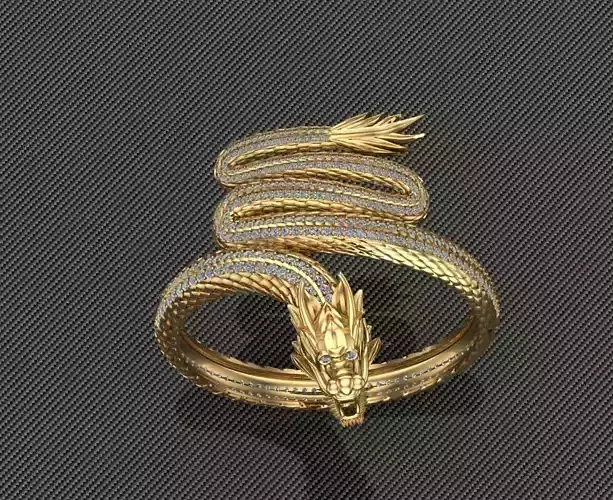1/8
Not to be confused with Dragon lizard, Komodo dragon, Draconian, Dracones, or Dragoon.This article is about the legendary creature. For other uses, see Dragon (disambiguation).
Illustration of a winged, fire-breathing dragon by Friedrich Justin Bertuch from 1806
Qing-era carved imperial Chinese dragons at Nine-Dragon Wall, Beihai Park, Beijing
Dragon-shaped bows on ships in Ystad, Sweden, resembling Viking longshipsA dragon is a magical legendary creature that appears in the folklore of multiple cultures worldwide. Beliefs about dragons vary considerably through regions, but dragons in Western cultures since the High Middle Ages have often been depicted as winged, horned, and capable of breathing fire. Dragons in eastern cultures are usually depicted as wingless, four-legged, serpentine creatures with above-average intelligence. Commonalities between dragons' traits are often a hybridization of feline, reptilian, mammalian, and avian features. Some scholars believe large extinct or migrating crocodiles bear the closest resemblance, especially when encountered in forested or swampy areas, and are most likely the template of modern Asian dragon imagery.[1][2]
Etymology
An early appearance of the Old English word dracan in Beowulf[3]The word dragon entered the English language in the early 13th century from Old French dragon, which, in turn, comes from the Latin: draco (genitive draconis) meaning huge serpent, dragon, from Ancient Greek δράκων, drákōn (genitive δράκοντος, drákontos) serpent.[4][5] The Greek and Latin term referred to any great serpent, not necessarily mythological.[6] The Greek word δράκων is most likely derived from the Greek verb δέρκομαι (dérkomai) meaning I see, the aorist form of which is ἔδρακον (édrakon).[5] This is thought to have referred to something with a deadly glance,[7] or unusually bright[8] or sharp[9][10] eyes, or because a snake's eyes appear to be always open; each eye actually sees through a big transparent scale in its eyelids, which are permanently shut. The Greek word probably derives from an Indo-European base *derḱ- meaning to see; the Sanskrit root दृश् (dr̥ś-) also means to see.[11]
Historic tales and records
Several bones purported to belong to the Wawel Dragon hang outside Wawel Cathedral, but actually belong to a Pleistocene mammal.Draconic creatures appear in virtually all cultures around the globe[12] and the earliest attested reports of draconic creatures resemble giant snakes. Draconic creatures are first described in the mythologies of the ancient Near East and appear in ancient Mesopotamian art and literature. Stories about storm-gods slaying giant serpents occur throughout nearly all Near Eastern and Indo-European mythologies. Famous prototypical draconic creatures include the mušḫuššu of ancient Mesopotamia; Apep in Egyptian mythology; Vṛtra in the Rigveda; the Leviathan in the Hebrew Bible; Grand'Goule in the Poitou region in France; Python, Ladon, Wyvern and the Lernaean Hydra in Greek mythology; Kulshedra in Albanian Mythology; Unhcegila in Lakota mythology; Jörmungandr, Níðhöggr, and Fafnir in Norse mythology; the dragon from Beowulf; and aži and az in ancient Persian mythology, closely related to another mythological figure, called Aži Dahaka or Zahhak.
Nonetheless, scholars dispute where the idea of a dragon originates from[13] and a wide variety of hypotheses have been proposed.[13]
In his book An Instinct for Dragons (2000), David E. Jones (anthropologist) suggests a hypothesis that humans, like monkeys, have inherited instinctive reactions to snakes, large cats, and birds of prey.[14] He cites a study which found that approximately 39 people in a hundred are afraid of snakes[15] and notes that fear of snakes is especially prominent in children, even in areas where snakes are rare.[15] The earliest attested dragons all resemble snakes or have snakelike attributes.[16] Jones therefore concludes that dragons appear in nearly all cultures because humans have an innate fear of snakes and other animals that were major predators of humans' primate ancestors.[17] Dragons are usually said to reside in dark caves, deep pools, wild mountain reaches, sea bottoms, haunted forests, all places which would have been fraught with danger for early human ancestors.[18]
In her book The First Fossil Hunters: Dinosaurs, Mammoths, and Myth in Greek and Roman Times (2000), Adrienne Mayor argues that some stories of dragons may have been inspired by ancient discoveries of fossils belonging to dinosaurs and other prehistoric animals.[19] She argues that the dragon lore of northern India may have been inspired by observations of oversized, extraordinary bones in the fossilbeds of the Siwalik Hills below the Himalayas[20] and that ancient Greek artistic depictions of the Monster of Troy may have been influenced by fossils of Samotherium, an extinct species of giraffe whose fossils are common in the Mediterranean region.[20] In China, a region where fossils of large prehistoric animals are common, these remains are frequently identified as dragon bones[21] and are commonly used in traditional Chinese medicine.[21] Mayor, however, is careful to point out that not all stories of dragons and giants are inspired by fossils[21] and notes that Scandinavia has many stories of dragons and sea monsters, but has long been considered barren of large fossils.[21] In one of her later books, she states that, Many dragon images around the world were based on folk knowledge or exaggerations of living reptiles, such as Komodo dragons, Gila monsters, iguanas, alligators, or, in California, alligator lizards, though this still fails to account for the Scandinavian legends, as no such animals (historical or otherwise) have ever been found in this region.[22]
Robert Blust in The Origin of Dragons (2000) argues that, like many other creations of traditional cultures, dragons are largely explicable as products of a convergence of rational pre-scientific speculation about the world of real events. In this case, the event is the natural mechanism governing rainfall and drought, with particular attention paid to the phenomenon of the rainbow.[23]
REVIEWS & COMMENTS
accuracy, and usability.










